The OnePlus One Review
by Joshua Ho on November 19, 2014 8:00 AM EST- Posted in
- Smartphones
- Android
- Mobile
- OnePlus
Camera UX
For the most part, the OnePlus One has a generally standard camera system for 2014 smartphones. With a 6P lens system, F/2.0 aperture, and Sony IMX214 camera sensor, the OnePlus One has a relatively standard camera system for today's smartphones. The focal length is similar to most smartphones on the market at a relatively wide 3.8mm length, which makes it equivalent to a 28mm focal length when accounting for the crop factor of the sensor. The front facing camera has an OmniVision OV5648 sensor, which is a 5MP, 1.4 micron, 1/4 inch sensor, with an F/2.0 aperture at 2.67mm focal length. This means that the field of view is similar to the rear-facing camera at about 29mm accounting for the crop factor.
While the camera hardware is relatively standard, the camera interface is definitely a unique take, and is the first time that I've been able to use Cyanogen's camera UI. In general, this UI feels like a mix of the old Google Camera, along with an immense amount of complication and not much explanation. For example, in the settings there's an ISO selection menu. While this is nothing to talk about normally, there's a setting called "Auto (HJR)". The only way for me to learn about this setting is by searching for it on Google, which explains that it favors higher ISOs to reduce the effects of shaky hands. As of the latest 44S update, this crashes the camera any time I try to take a photo in low light. To further explain the point, there are plenty of options in the video size setting, but a huge number of them are completely unexplained. While one might easily guess what 4K UHD or HD 1080p is, I find it difficult to believe that 4k DCI, CIF, or QCIF are self-explanatory. Interestingly enough, turning RAW capture on or off also has an effect on the maximum shutter speed, something that isn't actually detailed anywhere.
While an unfamiliar UI is not really a massive issue, there are some fundamental flaws with how the UI works. One of the most obvious flaws is the aspect ratio of the preview, which is 16:9, when output images can have a 4:3 aspect ratio. This makes it impossible to accurately frame an image. In order to do the ISO chart test, it was necessary to use Google Camera to frame the chart before switching back to the Cyanogen camera.
In addition to all of this, the scene selection UI doesn't have much thought put into it. All filters and all scene modes are integrated into a single menu, which is navigated by swiping up and down on the preview. This wouldn't really be an issue but when there are 31 options to swipe through this really gets to be a bit much to handle. There is a list option that can be found by going through the menus though, which is a bit better at organizing information. Unfortunately, most of the scene options are a bit nonsensical. The "night" modes don't actually change anything (ISO and shutter speed seem to be identical), and pretty much everything else is unclear on what it does. The one interesting mode is the slow shutter mode, which sets ISO to 100 and allows the exposure time to go as high as 8 seconds for high-quality photos on a tripod. This is also broken as of the 44S update, which causes the camera to crash until the phone is rebooted. I suspect that OnePlus is better off exposing full manual controls instead of trying to cover every possible edge case with a large number of scene modes that may or may not change anything. There's also no way to get a grid to try and frame images properly.
Speaking of ISO and shutter speed values, while the camera UI was mostly responsive in previous versions, around the 38R OTA I saw a dramatic shift in the auto exposure algorithm as it went from a maximum of 4500 ISO and around 1/11 second shutter speed to 4100 ISO and 1/6 second shutter speed. This has effectively made it impossible to use the camera at night, as there is no OIS present to reduce the effects of even slight hand shake. Overall, all of these issues make the OnePlus One quite frustrating to use as a camera.
Aside from these niggles with the camera application that can generally be resolved by using Google Camera, another area of evaluation is shot to shot latency, along with focus latency. To this end, the device was tested by pointing the camera at the ISO chart with strong lighting to be able to reach base ISO and timing how long the camera took to focus on an object along with how quickly the device could take a photo.
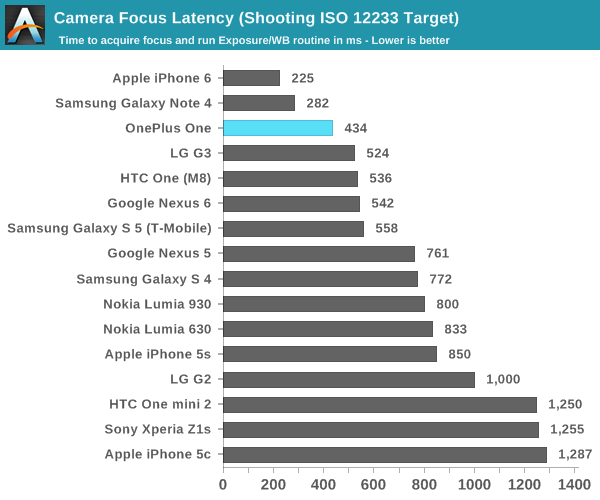
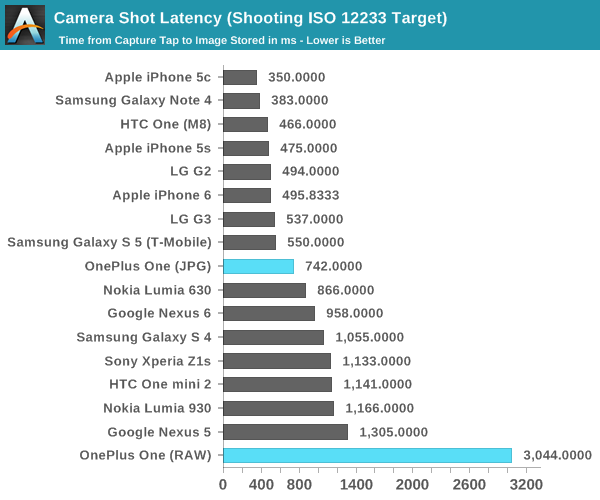
The OnePlus One does do surprisingly well in our focus test, setting a rather respectable focus latency around the same speed as the competition. On the other hand, the default capture speed is really quite long, although this is really mostly due to the RAW capture as turning off RAW capture dramatically speeds up response time in the camera to a much more respectable ~750 ms.


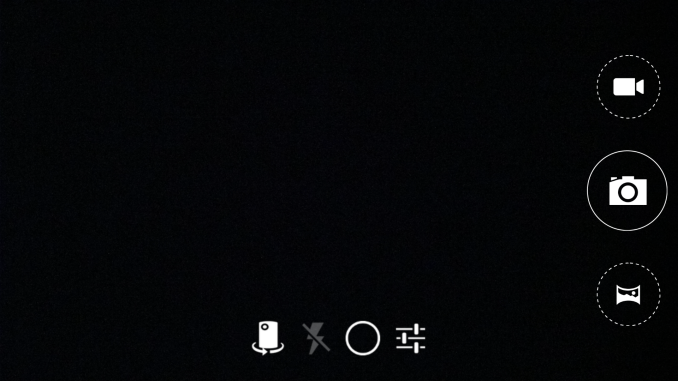

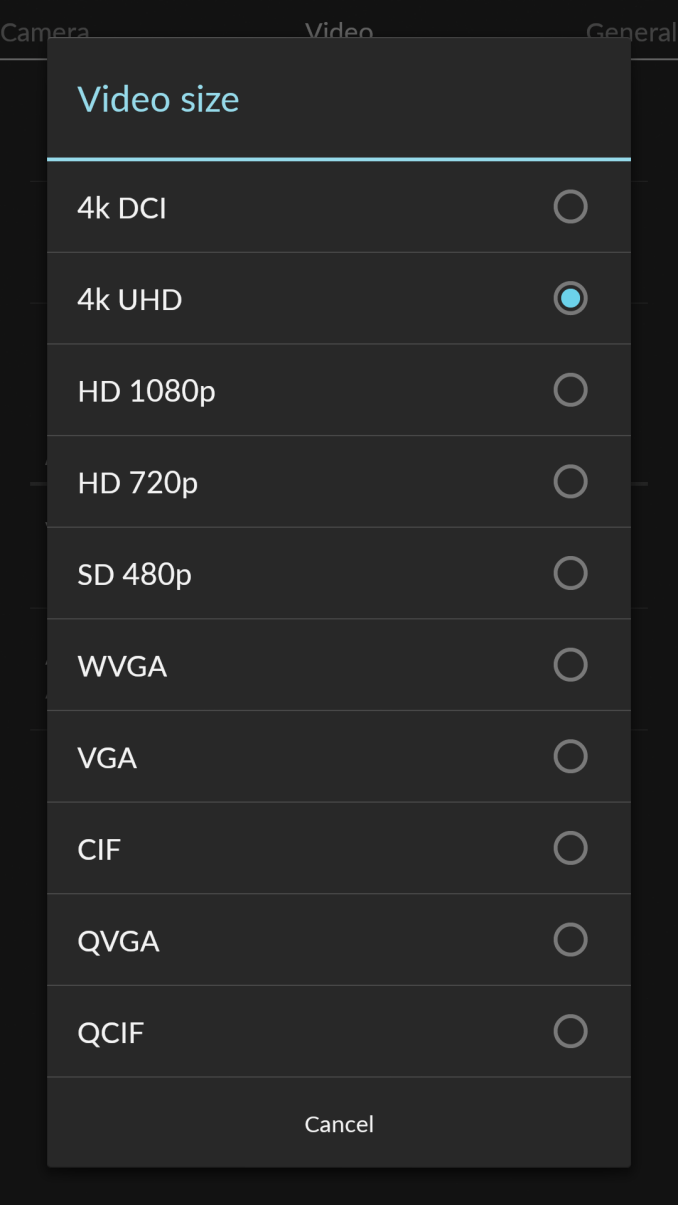


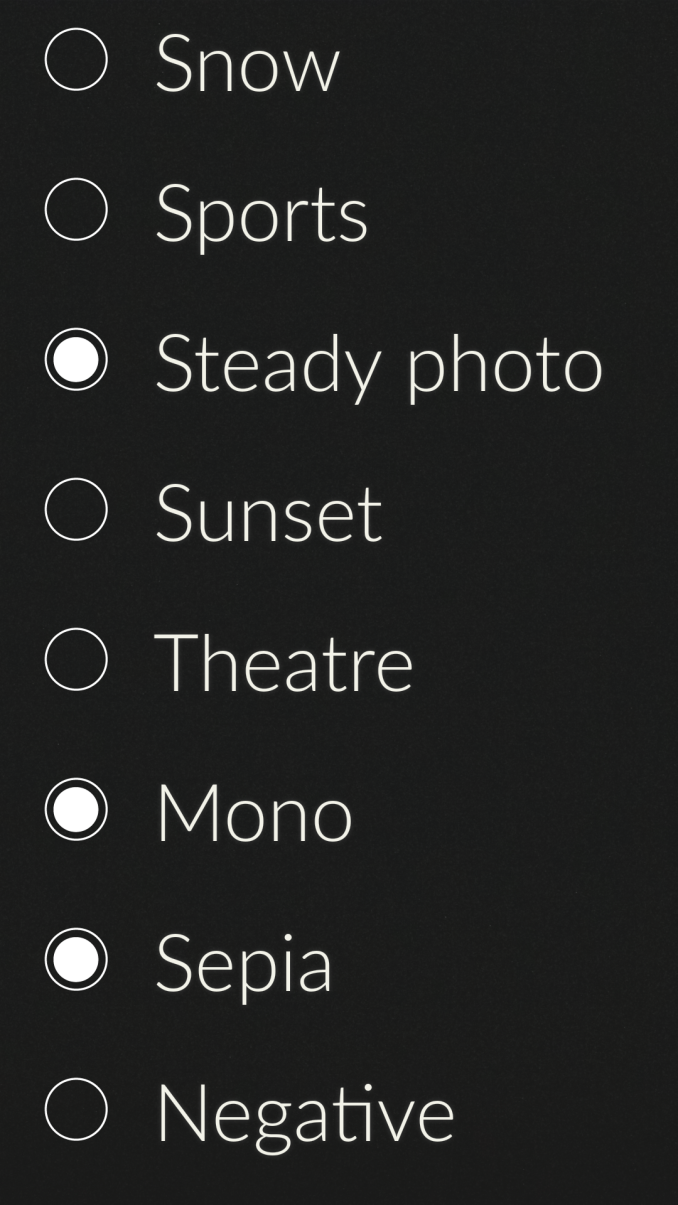
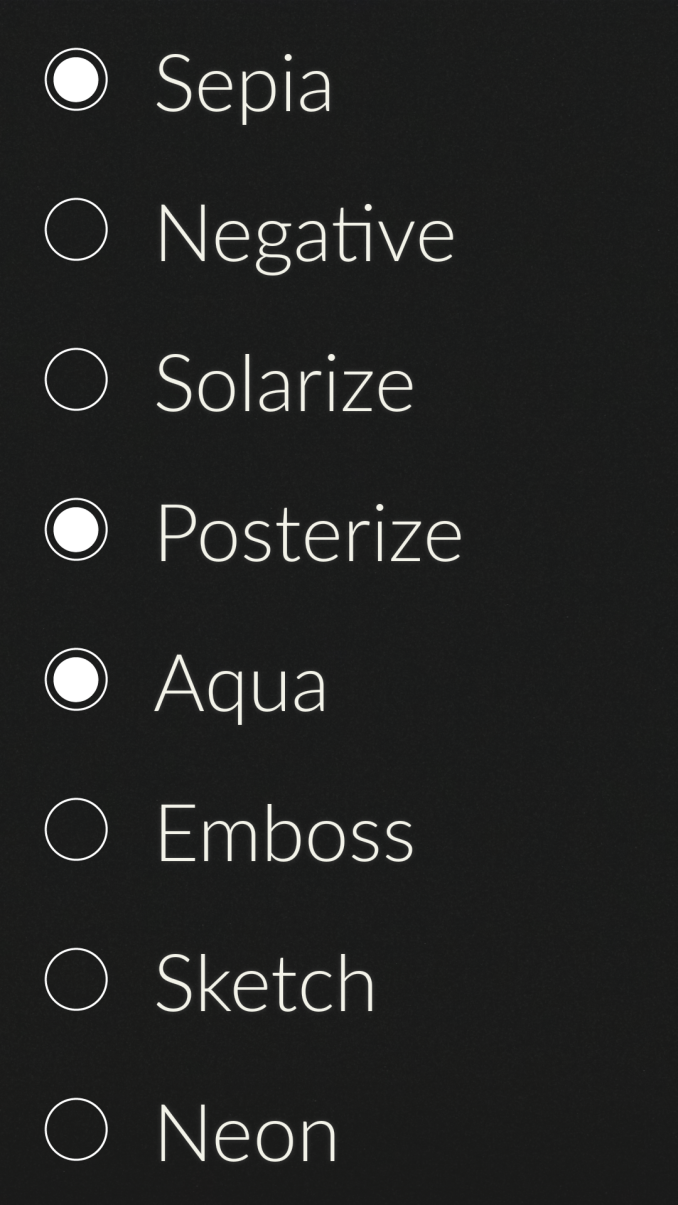
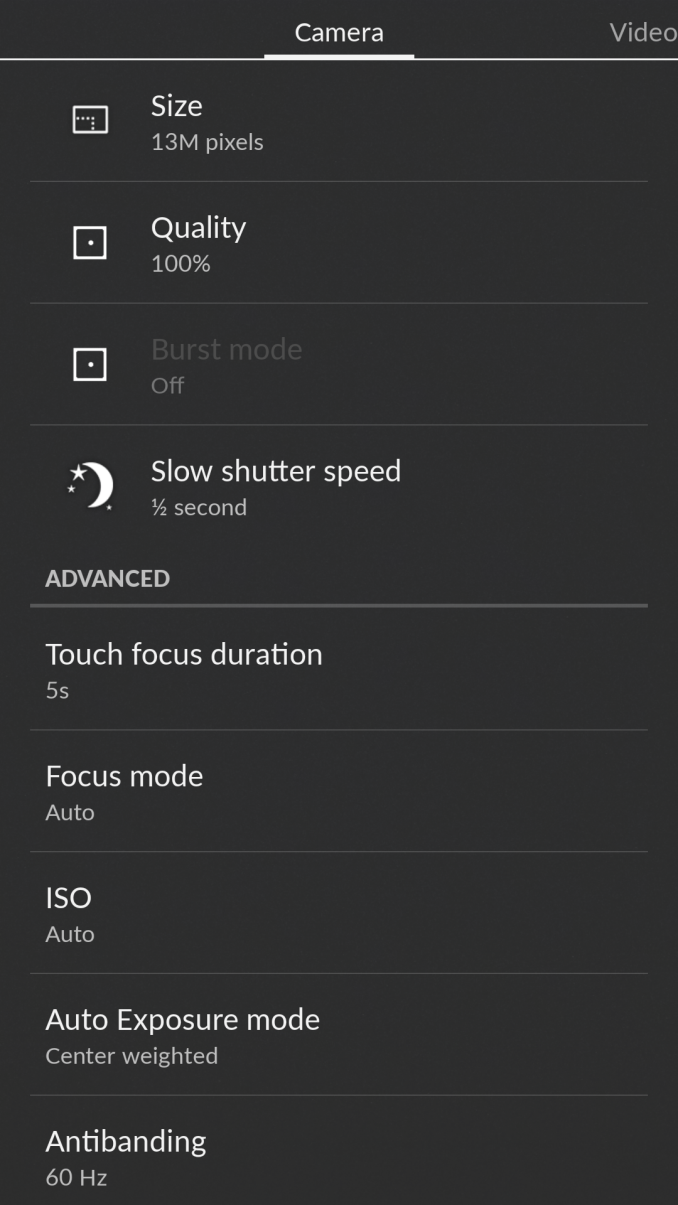









148 Comments
View All Comments
wyewye - Thursday, November 20, 2014 - link
An article beginning with "There's really not much else to be said" ...Why do you keep this smug asshole on your team, Anand? Are you really looking to drive away viewers?
Regarding the OnePlus One, this config would have been decent in mid 2013. Coming in late 2014, this phone is not only not a flagship killer but average at best.
Harry_Wild - Thursday, November 20, 2014 - link
"Reception, at least for T-Mobile US' band 4/AWS LTE is noticeably worse than most devices that I've tried. "I'm a T-Mobile user; and this above result sure makes me uneasy to even consider it as a purchase! Hopefully, One Plus, can find some way to fix the LTE for T-Mobile so it can be more clear!
Munna2002 - Friday, November 21, 2014 - link
I'm a T Mobile user and haven't had issues with the OPO reception in the NYC metro area. LTE speeds are as fast as those observed with a Samsung S3 and S5.littlebitstrouds - Thursday, November 20, 2014 - link
The reason this phone is so popular isn't that it matches up perfectly with flagships, even though it does it's best job, but rather that for $350 off contract it allows you to finally have a near flagship phone on non-contract services without breaking your bank. I went from an EVO LTE with $99 a month from sprint, to $50 a month with t-mobile non contract. $50 savings a month, and I don't have to use last year's gear while doing it.BabelHuber - Thursday, November 20, 2014 - link
I do not understand why CM is criticized because of its options:I like them and I use them - for me a stock Android phone has too few options. I need to use Xposed/ Gravitybox to get the options back, otherwise I can't stand it.
Also I do not understand what is wrong with CM's Theme Engine: It works well and there are lots of themes I really like.
Of course there are also themes which do not work correctly one way or the other, but that's not the Theme Engine's fault.
So I would see it exactly the other way round: CM adds sensible features to Android. Of course there are also lots of settings in CM which I don't use, like the profiles.
But why should I be embarassed about this? I use what I want and I ignore the rest. That's what options are for.
Also I didn't have difficulties getting used to CM at all.
So I think from the software side Joshua Ho got it wrong.
If I would be malicious I'd say it's no wonder that the Anandtech staff likes iOS so much, because they seem to be too stupid to use a fully-featured OS :-)
srkelley - Thursday, November 20, 2014 - link
It's not that they're dumb, far from it, but that the presentation of the options can leave a lot to be desired. Joshua Ho points out the number, but the number of options alone isn't the real issue. It's too number made available to people that require them to either search outside of the ui to understand or to learn what they do through trial and error.I'm perfectly fine with that, I have a OPO (https://plus.google.com/+ShirondaleKelley/posts). Still, such a thing must be cited. Even power users just want to be users sometimes. Maybe they just want to exert their power through workflows instead of configuration. Maybe they want to be able to recommended a good phone to friends without becoming their personal and default support option. Having such a thing the review reminds you of what the norm is and allows for a much more comprehensive review. It's constructive criticism, not scalding or venomous criticism.
Since we're all power users here, maybe we would still get to phone for our friends but decide to install miui or preconfigure certain items. A review like this certainly helps with the decision of what to recommend and how to handle it.
BabelHuber - Friday, November 21, 2014 - link
In my experience, people like CM's options, even the 'regular' users.My GF uses CM11 on her Samsung Galaxy Tab 8.4 - I had to install it because she hates the Samsung-UI the device came with. With CM, she is satisfied with the device.
I've also shown two friends how to install CM on their older devices (SGS2 and HTC Desire HD). They also like it.
Nobody said that he/she is confused. Nobody wants to have less options.
So I still think that CM is fine and I still do not understand how somebody would prefer less options. It just does not make sense to me.
srkelley - Sunday, November 23, 2014 - link
Yes, and that's good for them.Again, it's not solely the number but in how they're presented. If it had a more cohesive, polished presentation then the number really wouldn't matter. The way that some part of the interface exposes (or doesn't) functionality is the true issue here.
No, that doesn't mean that everyone will have trouble. I just don't believe that you should have search outside of a ui to understand how to complete basic and intermediate level items. That can be the cause with some of the cm11 functions. It's nowhere near all of them, it's something that I see the team fixing over time. It used to be way more daunting in the beginning, the team has been making great improvements while adding more functionality and I love it for that.
slfisher - Monday, November 24, 2014 - link
Do you have a "CM for Dummies" reference to point to on how to configure it? thanks.icekyuu - Monday, November 24, 2014 - link
Try this - http://cornerplay.com/2014/08/05/cyanogenmod-onepl...For the record, I love CM's customization options.
I vastly prefer the Google Camera app though. I suspect what happened is the reviewer got frustrated with the CM Camera app and that boiled over for everything else. When everything else is actually fine.